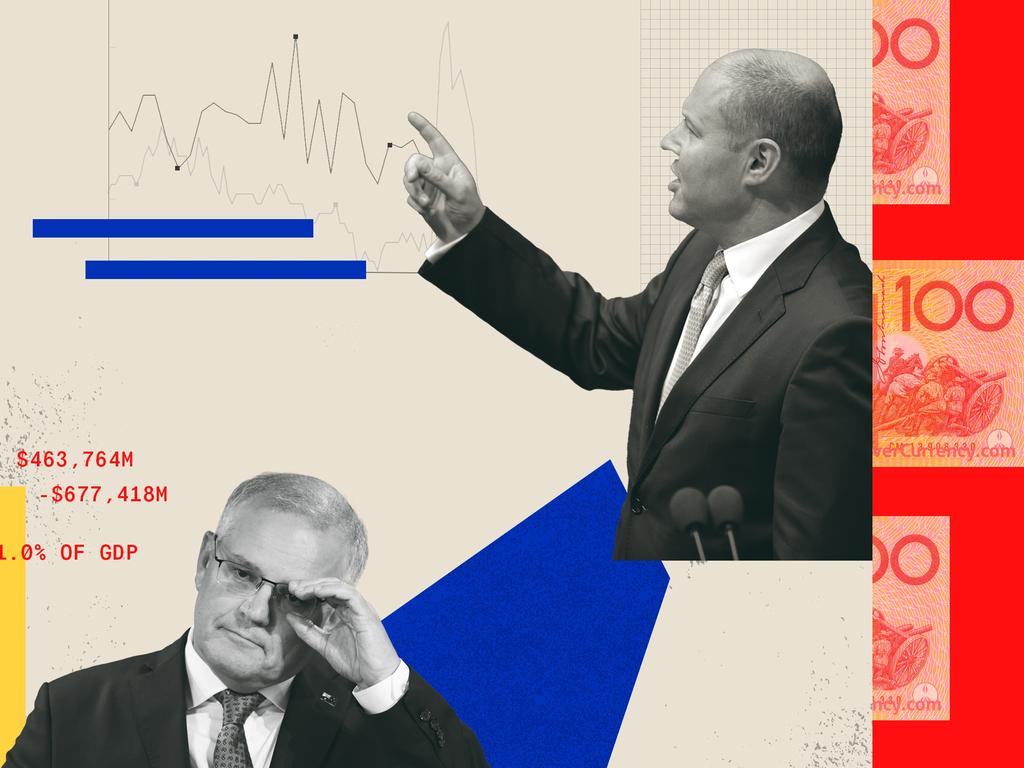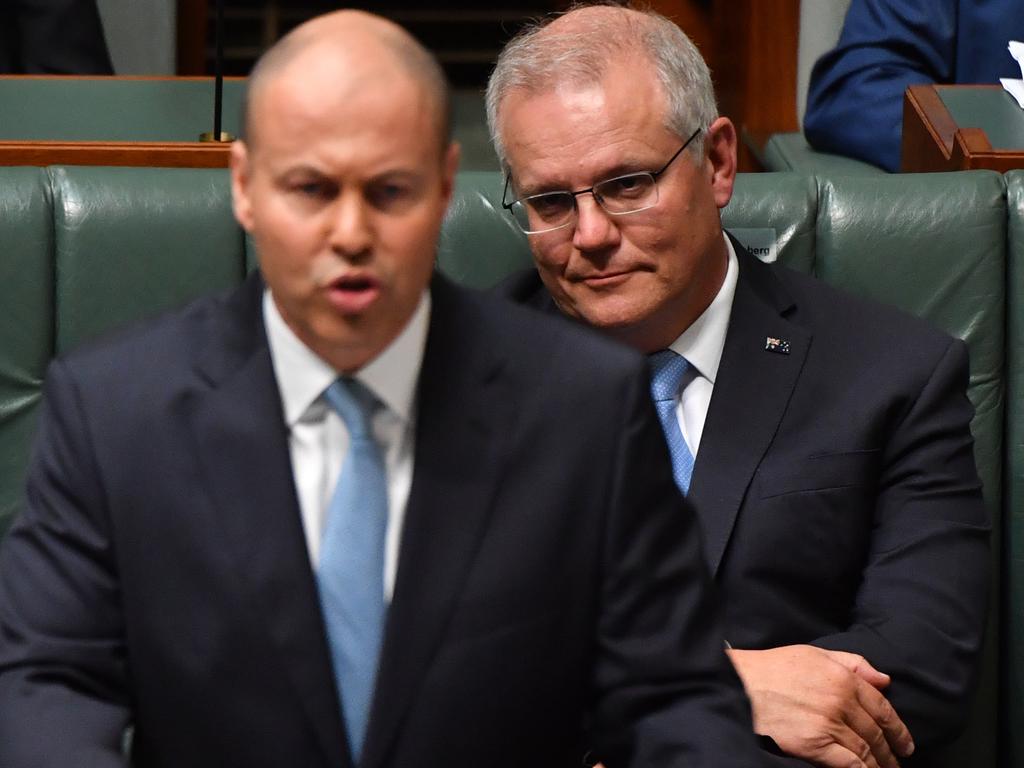Budget 2021: Comeback Kid lets it rip in pitching to the True Believers


And guess what? While his right flank will mutter Keynesian overreach and his political opponents will zero in on the strategy’s soft underbelly — it’s wages — the Treasurer is convinced he’s both the workers’ saviour and corporate Australia’s reformer at a time of historic distress and uncertainty.
Frydenberg is the Comeback Kid: it’s the budget narrative, and you’ll no doubt see the taxpayer-funded ads this winter. “Australia is coming back,” he said to open his speech on Tuesday night.
“We have come so far since the height of the pandemic. Treasury feared unemployment could reach 15 per cent and the economy contract by more than 20 per cent. This would have meant two million Australians unemployed. It would have been the equivalent of losing the agriculture, construction and mining sectors.”
Budget 2021: The big picture — what the budget means for you
Nobody saw this recovery coming. Even in his wildest dreams and, frankly, you can tell the Morrison government’s mainstays aren’t getting much sleep, the Treasurer would not have contemplated a scoreboard that has unemployment at 5.6 per cent. He could not resist saying it was lower than when the Coalition came to government in 2013.
“Jobs are coming back. The economy is coming back. Australia is coming back. And this budget will ensure we come back even stronger, securing Australia’s recovery.”
Frydenberg is also a throwback to an era when government actually controlled the economy, setting prices and controlling the borders, or at least the goods that hit our docks from overseas. Perhaps not in every deed, but certainly in spirit.
HC “Nugget” Coombs, Fabian and adviser extraordinaire to seven prime ministers, is the unlikely archetype for the Liberal member for Kooyong.
Coombs thrived in the post-war era, where national reconstruction was the grand project for politicians and the public servants who enabled them.
How did Coombs describe his influence and his mission? It was as an “interferer” repairing the damage he believed markets caused or could not fix.
By necessity, in the dim light of a recovery built on borrowed money, and lots of it, the Treasurer is not leaving any hands empty as he dishes out dollars. There is new money for aged care, childcare, housing, skills and mental health.
This social edifice, much of it demanded by royal commissions and the gender politics on which the government looks habitually clueless, is baked into the budget.
Down the track, of course, there must be a reckoning for the expansion of the state. This means either spending cuts on services and the bureaucracy, or a sustainable way to fund an ageing Australia’s growing list of wants that does not savage young workers with high taxes or rely on cyclical jackpots from high prices for shipping minerals.
In case you hadn’t noticed, we are in a new era of macroeconomic management, where Frydenberg can assume the role of helmsman, his influence over the economy almost without precedent because old policy levers like interest rates and wage setting have had their day. Budget policy is the main game.
This financial year, Canberra’s spending will hit 32 per cent of GDP. In the global financial crisis, payments reached 25.9 per cent. Wayne Swan, eat your heart out!
The sheer scale of direct support to the economy is knee-shakingly bracing, if not brazen: $291bn in direct support to families and businesses, or 14.7 per cent of GDP, and counting.
Budgets are filled with numbers and at some point even the most ardent devotees switch off amid a fact blizzard.
So here’s the secret beneath Frydenberg’s projected receipts and payments, the endless list of measures and wobbly-wiggly forecasts. The budget is essentially about values, power and the raw impulses of life.
It always has been.
Aided and abetted by Scott Morrison — who can say if there’s a $100 note thickness between them? – the Treasurer has been guided by his instincts. He’s a politician. Plus, those folks in grey suits who would normally be trying to hold them back are saying “Let it rip”.
From here, as the election comes into view, all the incentives are for Morrison and Frydenberg to do more, not less, with fiscal policy. Remember, last year we had several emergency mini-budgets, with escalating ambitions and costs. There were cash cheques, a doubling of the dole, a generous initial JobKeeper payment (and its modifications) and a hefty budget in October.
This budget is not the last word on Canberra largesse before voters head to the polls. Frydenberg may soon resemble a Sheik of Tweak, and not in terms of messaging spin, where he is indefatigable. We should expect a pre-election economic statement, with some good news on tax for workers.
In this flurry of fiscal adjustment, voters forget. “What have you done for me lately?” is the hard calculus of electoral politics in a season of plenty.
Amid all these new measures, the reality is that people only pay attention in fits and starts, and this budget splashes money about so enthusiastically that it will soon fade into COVID-19 amnesia.
Treasury is not short of revenue, for now. This budget extends the Low and Middle Income Tax Offset at a modest $7.8bn. What was meant to be a temporary measure, and an odd one at that, distorts the tax system. But LMITO goes to the voters the Coalition needs to keep in its tent.
The bigger test will be on stage three tax cuts, due to begin in July 2024 and geared to high-earners. Naturally, flattening the tax system so that 95 per cent of taxpayers pay no more than 30c in the dollar is tax relief for those who pay the lion’s share of it.
But if he is tempted to bring that legislated third stage forward, Frydenberg will be flayed by Labor and the social media “gibberati”. Yet there he was at the dispatch box, espousing those “enduring values” at the heart of the plan to secure the recovery.
“Reward for effort” was at the top of the Treasurer’s list, and then he added those values he said the Coalition always stood for: “The power of aspiration and enterprise. Upholding personal responsibility. And always providing a helping hand to those who need it.”
Frydenberg is pitching to the True Believers. The jury is out on which side of the chamber. But here’s the thing, the future is shrinking, not expanding. We will be smaller, older and slower.
Our frontier of possibility is severely limited because our economy is living off sugar, not the protein of the three Ps: productivity, participation and population.
Treasury tells us our speed limit for growth is going to be lower, old Europe slower. In the recent past, our economy grew at an average of 2.75 per cent, often by more.
Now, over the medium term, potential GDP is projected to remain below its pre-pandemic “level”. But potential GDP “growth” (and that was often insipid before the crisis) is estimated to fall below 2 per cent a year.
The slow lane is not where Australia wants to be nor will it be happy to accept the wage growth that goes with it.
That’s the ultimate challenge for Frydenberg as would-be agent of social and economic change. Until we feel the heat of pay rises, the comeback’s just another verbal tweak.







It’s taken three budgets, but Josh Frydenberg has revealed himself as the “great interferer”, an inveterate spender and social engineer. But not, in fact, a Liberal maverick in an era of “whatever it takes” to get through the pandemic’s long night.